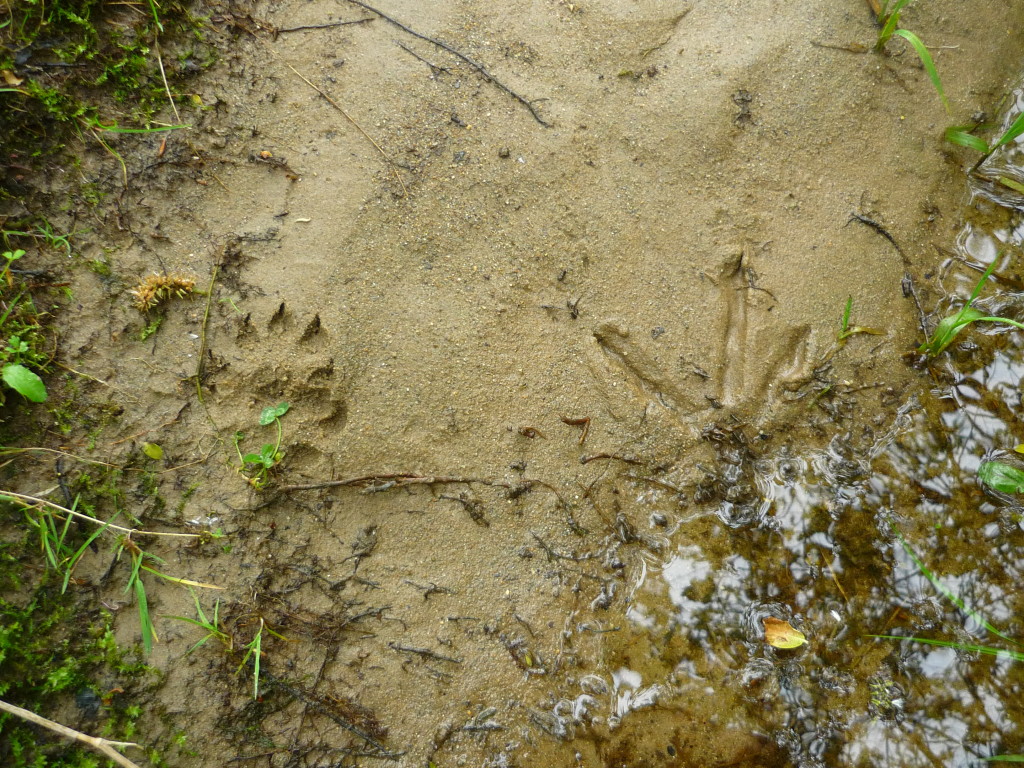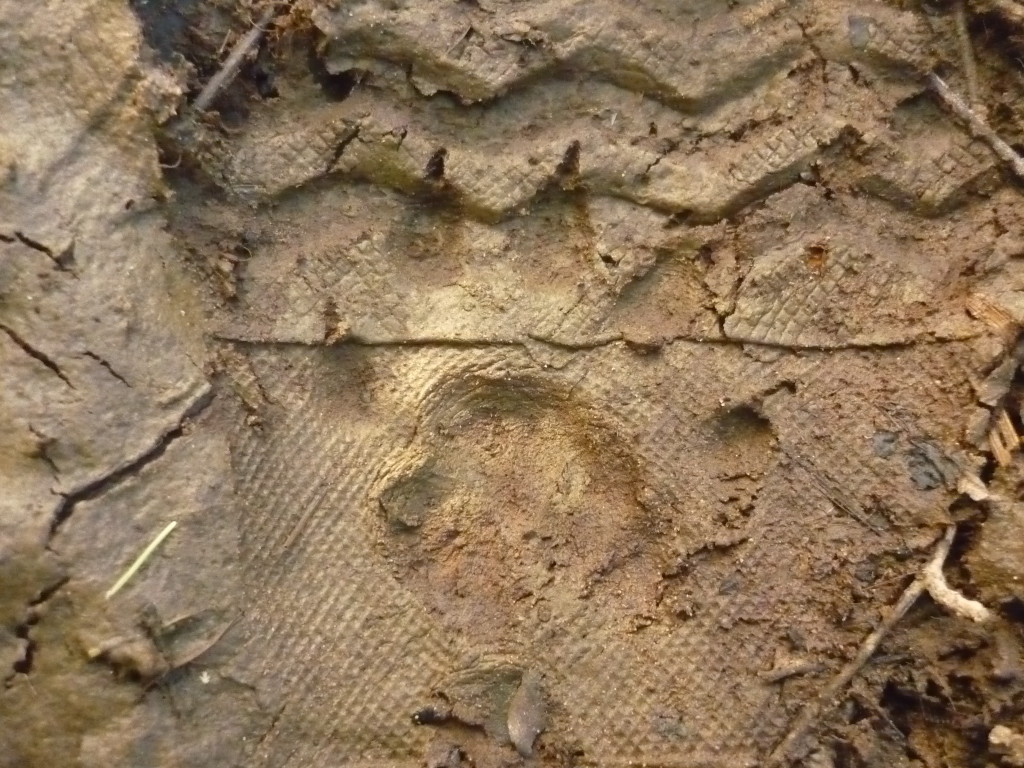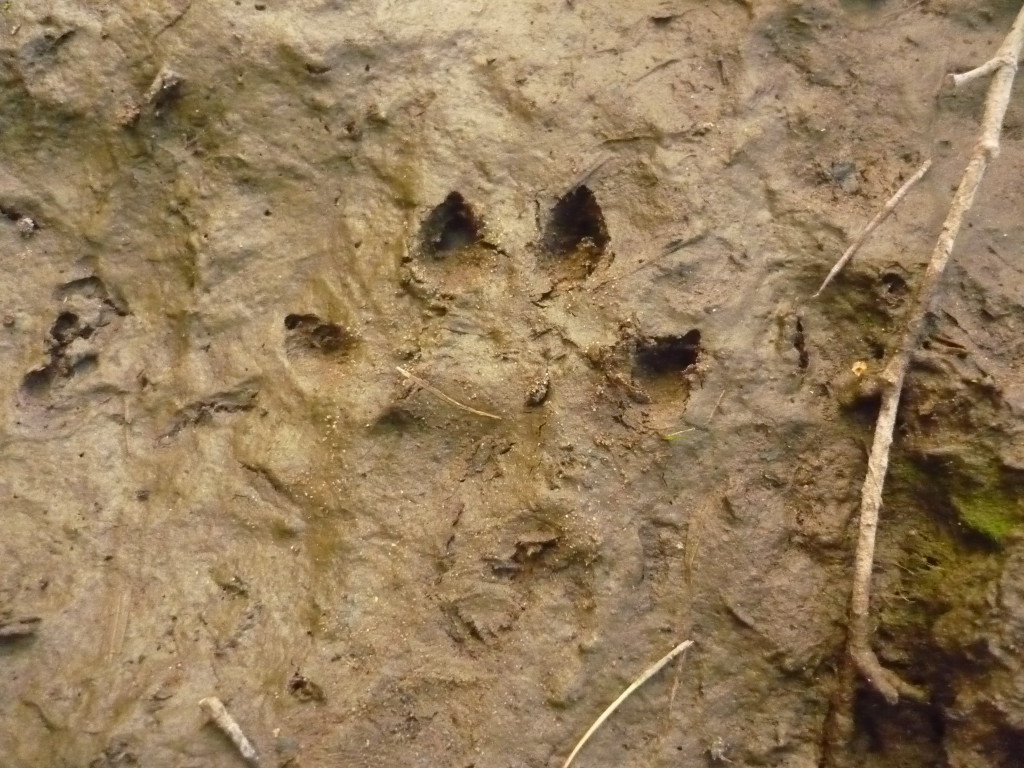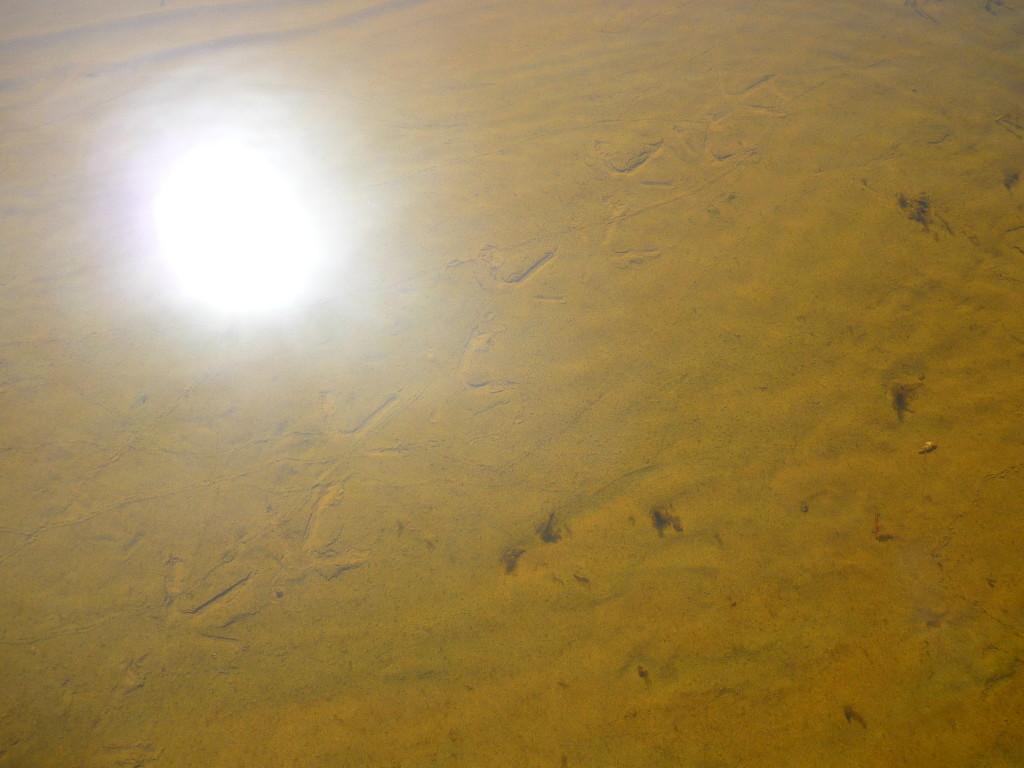By Sean Fagan

Left of photo: otter tracks. Right of photo: the large track of a grey heron, Ardea cinerea. Note the less-detailed, softer, rounded edges of the heron tracks and the fresher, more crisp detail of the otter tracks. (photo: Sean Fagan).
Learn How to Track the European Otter (Lutra lutra)
.
The European otter, Lutra lutra, is a medium-sized, carnivorous, semi-aquatic mammal with partially-webbed feet. They feed predominantly upon aquatic prey such as crabs, fish, frogs, water-birds and crayfish.
The body shape of otters is a noteworthy feature in understanding otter behaviour. They have short, squat legs and a proportionally long, somewhat cylindrical body.
Their long body means that they have a large body surface area relative to their volume which means they lose a lot of body heat. Coupled with the fact that otters hunt in water, and water conducts heat about 25 times more efficiently than air, otters lose heat very effectively.
A strategy of otters to maintain optimal core temperature is to be very active and high activity levels requires a lot of calories.
As a result, otters are highly efficient hunters.
Not only do they hunt during the day they can also hunt effectively at night with the aid of their large, sensitive whiskers and tactile, semi-grasping feet.
In his inspiring nature book, Ring of Bright Water, the author Gavin Maxwell takes care of a number of wild otters. He describes how one otter, as an adult, exhausts his pet springer spaniel (quite an achievement considering how energetic spaniels are) until eventually the spaniel avoids the rambunctious otter.
If you ever get the opportunity to watch or track otters, do so - you will be most likely, richly rewarded.
Thankfully, otters in Britain are on the increase.In England, for example, there would seem to be a reassuring resurgence in otter numbers.
(Guardian Article: Otters back in Every County in England)
In addition, Ireland (in large part due to its long coastline) has the highest otter population density in Europe.
Personally, otters are one of my favourite animals to track.
When you track and observe otters often, you can get the impression they are an unusually active, inquisitive animal with a proclivity for play (young and adult otters alike are well known for playing).
I’ve been lucky to observe otters quite a bit in the wild.
Many times I’ve witnessed them playing – chasing each other and play-wrestling in water for long periods of time. Even alone, they will sometimes chase and catch fish with a playful exuberance.
They are a joy to observe.
And a joy to track.
OTTER TRACKS
Otters have 5 toes. At the end of each toe is a short, sharp claw.
The toes are usually splayed in a wide, semi-circle arrangement.
Often the smallest toe will not show in the track, with the result that the track will appear to have 4 toes.
One of the key features of otter tracks is the shape of the toe pads and how the claws are attached to the toes.
They have a typically teardrop shape.

(Above) The five toes of this otter track can clearly be seen. Note the short, sharp claw marks and how the toes and claws have a distinctive teardrop shape. Another distinctive feature is how the toes are widely splayed in a semi-circular arrangement. This otter track was overlain upon the zig-zag threads of a human boot (Photo: Sean Fagan).

As a point of contrast to the previous photograph, this otter track shows only four toes and no central pad. This is a common tracking occurrence and something to be wary of when identifying a track. The key identification features of this track are the wide splay of the toes in semi-circular arrangement, the presence of the small, sharp claws, the teardrop shape of the toes and claws (especially the rightmost toe & claw) and the overall width of the this track (5.5cm). All these factors, combined, strongly indicate this is an otter track. Finally, the track was found beside a large, fish-rich, rural river (Photo: Sean Fagan)
.
.
Often the central pad and rear pad (heel pad) will show in the tracks, but there is a great variety in how they show up in the tracks.
What is a more reliable track feature are the presence of 4-5, widely-splayed, tear-drop shaped toes with conspicuously short claws. Combining these features with an overall, approximate track length and width of 6-7cm by 5-6cm, respectively, will further confirm the track belongs to an otter.
As a final confirmation, don’t forget habitat. For obvious reasons, otter tracks are often found in association with bodies of water.
But habitat is not the most reliable of associations when it comes to otter tracks. Otters will occasionally make significant overland journeys to get from one body of water to another.
The webbing of otter feet rarely shows up in track unless the prints are firmly embedded in a soft substrate such as damp sand or deep mud.
WHAT ABOUT OTHER OTTER SPECIES?
Since many people that practice bushcraft these days often travel further afield to avail of exceptional wilderness areas there is a good chance of tracking otters in places further afield.
Thankfully, most otter species are roughly of similar size so there is a great similarity in track features and dimensions.
In North America for example, the North American river otter, Lontra Canadensis, is one such otter species that offers exciting possibilities for tracking in North America (especially in Alaska, Canada, west and eastern USA - where they occur).
I’m a great believer in transferring viable tracking skills aboard whenever the opportunity arises.
Using related animals from North America and Europe as an example…
Once you can recognise domestic cat tracks in Ireland and Britain, there is a good chance that the feline tracks of the Canada lynx, Lynx Canadensis, of the northern woods of Canada and Alaska, will strike a familiar cord (despite the obvious, larger track dimensions of the lynx).
Once you are thoroughly familiar with the tracks of the domestic dog, Canis lupus familiaris, then the very similar, dog-like tracks of a grey wolf (Canis lupus) in, for example, Yellowstone National Park, Wyoming, are much more familiar and much more identifiable as a dog-like animal (i.e. a grey wolf).
The same applies for the European badger, Meles meles, and the American badger, Taxidea taxus.
And the European otter and the North American river otter.
There is a solid commonality of track features amongst related animals that is well worth getting to know.
More about this in a later article : )
TOP TRACKING TIP: EXPECT TO SEE MORE!
Once, I come across an otter in the heart of Dublin city, hunting in the Royal canal during a winter’s night. I’m guessing the otter found the plentiful rudd and perch in the canal an irresistible lure.
Animals are generally more behaviourally versatile and unpredictable than is commonly perceived. A great, quick way to significantly improve your tracking and animal observational skills is to expect to see more.
To give a good example – the bobcat, Lynx rufus, is a medium-sized wild cat found mostly in the USA and Mexico. In many parts of its geographic range there can be a common belief among hunters, farmers and other people that work on the land that the bobcat has disappeared from a lot of areas even though there may be significant tracts of suitable bobcat habitat and prey in the area.
But, the bobcat still exists in a lot of these places.
Bobcats are (especially when persecuted) notoriously elusive. They will, for example, leap over trails to avoid leaving their scent and tracks on trails and can become predominantly nocturnal/crepuscular to avoid human persecution.
My overall point is, when you go in to a wild place throw away any preconceptions about what tracks you will find based on what animals you may or may not expect to see in a given area.
And I use the term, wild place, in the loosest sense of the term. A wild place could be local park, an old hedgerow along a small stream, a meadow. One thing is generally a sure thing – there are probably some wild animal tracks and sign somewhere in these pockets of nature.
Whether it be the minuscule jawbone of a mouse atop a fence post – left by a feeding kestrel, or a 2cm wide burrow entrance on a woodland floor indicating the presence of an underground bumblebee hive or the iridescent shimmer of insect wings encased within a bat dropping - there is always something to investigate, something to enjoy.
Casting aside our expectations when tracking - and expecting to see more, is a great way to expand tracking skills.
Why? Because tracks and sign are far more common and widespread than is commonly perceived.
.

Tracks can be found in unusual places. Here, the stealthy tracks of a Grey Heron, Adera cinerea, can be seen underwater, near a lake shore - where the heron walked slowly in the water stalking for aquatic prey (photo: Sean Fagan).
. Related articles on this website: . Related Articles:
- Otter Joy, by Environmentalist George Monbiot.
- Animal Tracks and Signs, Preban Bang and Preban Dahlstrom.
- Tracking and the Art of Seeing, How to read Animal tracks and Sign, Paul Rezendes.
- Ring of Bright Water, Gavin Maxwell.
- Tarka the Otter: His Joyful Water-Life and Death in the Country of the Two Rivers, Henry Williamson.
Additional Reading…
WHERE TO FIND OTTER TRACKS
.Otters are nearly always associated with water (lakes, rivers, streams and the sea) and the banks or shorelines of these habitats will show otter tracks if otters are present in the area.
They usually have quite long linear territories (up to 10 miles) associated with river and stream banks.
By carefully tracking along rivers, streams, lake shores and along seashores (especially in winter when rivers and streams are often flooded) – there is a good chance of coming upon otter tracks.
What is helpful is that there is usually an abundance of soft, damp substrates such as sand and mud associated with bodies of water, which show up very clear, track impressions.
Provided the water is relatively clean, has suitable prey and there is a lack of local persecution there is a good chance that an otter uses that waterway, for at least part of the year.
Be watchful of the seasonality of otter tracks. Often in winter, otters will leave fast-moving, flooded rivers and streams in favour of more sedentary bodies of water such as lakes and the sea.
In the future I will be covering otter sign such as burrows, scat and slides (yes, otters make slides into rivers banks and snow - for fun!)

Recent Comments